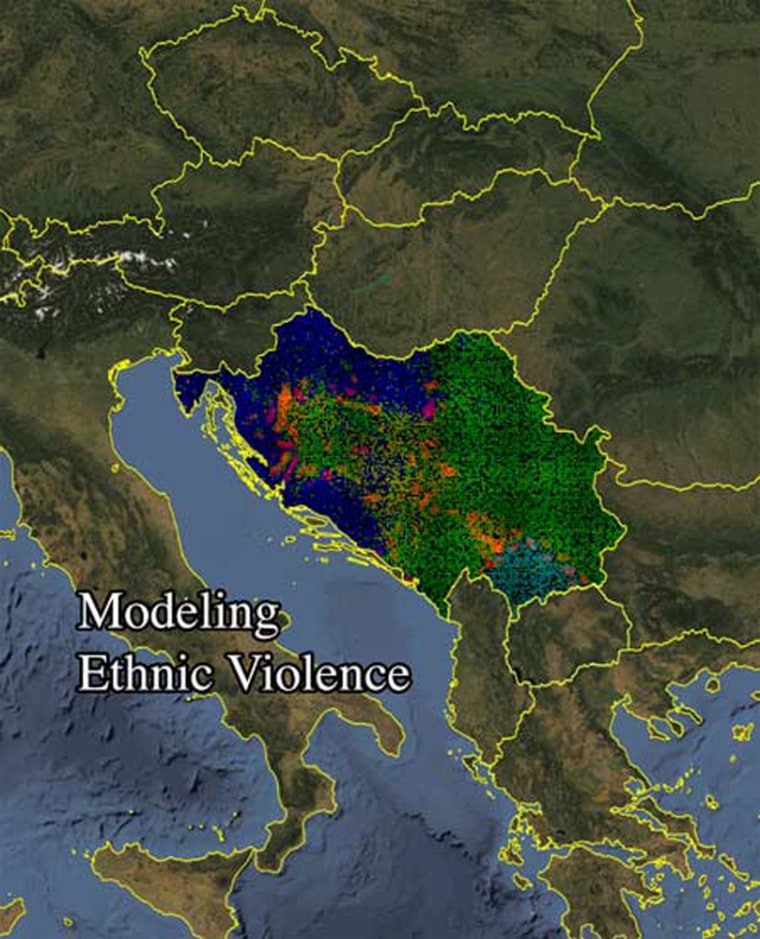Ethnic and sectarian violence that has plagued parts of Africa and Iraq in recent years can be predicted by using a model that examines the boundaries between different ethnic groups, a new study says.
While oppression of minorities, religious or political differences, and historical conflicts can be some of the triggers that motivate this type of violence, it is the structure of the boundaries that separate groups that enables communal violence, says study team member Yaneer Bar-Yam of the New England Complex Systems Institute.
If different ethnic groups are very well-mixed in a community, violence is less likely to occur; if boundaries between groups are clearly defined, violence is unlikely to occur. But when the boundaries blur, and the amount of mixing is "just right," the situation can become explosive.
"That's the case that tends to promote violence," Bar-Yam said.
Islands and peninsulas
In the case of some well-mixed communities, it becomes harder for any one group to establish a collective identity or identify any one space in the community as belonging to them, and so no one group can dominate any others. Public housing in Singapore actually uses this principle to prevent sectarian violence by requiring a certain population mix, Bar-Yam said.
"There's tension there; there are historical events, but there's no major violence," he told LiveScience.
Conversely, groups that are separated by fairly rigid boundaries may have some antagonism between them, be it from religious differences or historical conflict, but the boundary prevents mixing, which minimizes the risk of violence breaking out.
In places like Ireland, "you have groups that sit side-by-side; there's plenty of historical events that might cause violence, and there's no violence," Bar-Yam said.
But where there is not significant mixing or boundaries to separate groups, people will tend to move to areas where there are people like them. This natural behavior can create "islands" of one population within another population or "peninsulas" that stick out from boundaries into other populations — the blurred boundaries between groups in these cases can create situations that allow violence to erupt. The group surrounding an island may impose their cultural norms on the group inside the island, which was the case in the former Yugoslavia.
"If people are in circumstances where their cultural behavior is being imposed or imposed upon, then they may very well find reasons to have conflict," Bar-Yam said.
Predicting violence
The model developed by Bar-Yam and his colleagues starts with the characteristics of the population (or the number of people in each grouping) and identifies the locations of population islands and peninsulas of particular sizes and marks the borders of these groups with other populations as a prime area for outbreaks of violence.
To check how well their model predicted the locations of outbreaks, the researchers took population data from the former Yugoslavia and India and checked the model's predictions against the locations of actual conflicts during the Bosnian War and in recent years in India.
The model's results correlated well with the places outbreaks actually occurred, with a 90 percent match between prediction and reality.
The model works independently of the particulars of the conflict, so it does not matter who is the aggressor, Bar-Yam says, also pointing out that the model makes no value judgments.
"The specifics of the group are not what's important," Bar-Yam said. "[The model] doesn't say, 'These people are right and these people are wrong'."
Bar-Yam says that the model could be used now in places such as Iraq to predict where outbreaks of violence will occur, and could be used by governments to formulate policies to prevent any outbreaks.
"Ethnic violence is really a horrendous thing, and to be able to provide information that can help prevent ethnic violence is really, obviously important," Bar-Yam said. "And having scientific tools that can contribute to the dialogue about what should be done is not only important but it is in some sense an imperative."
